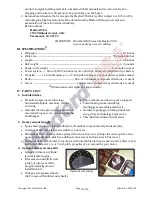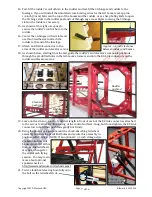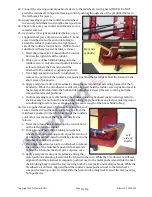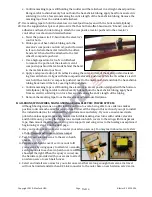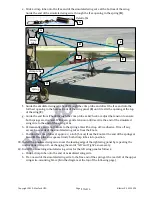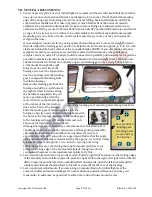
Copyright 2013: Maxford USA
Page
Blériot XI: S130926
Initial settings if you are using a non-computer radio:
Recommended Deflections
Elevators .................................... 25 degrees (1 inch) up and down as measured from the
trailing edge of the horizontal tailplane
Rudder ........................................ 25 degrees (1
1/4
inches) left and right from center
Ailerons ...................................... 20 degrees (
3/4
inch) up and down from center
4.
Preparation for transport and storage: For most people, an airplane of this size will not need to
have its wings removed for transportation or storage.* If you want to remove the wing, unhook
the ends of the springs from the upper wing-wire-mounting braces; with slack in the simulated
wing wires and leaving the lower ends of the wing wires attached, simply slide each wing panel
away from the fuselage, off from the wing rods, and fold the wing panels alongside the fuselage.
Reverse this procedure to resecure the wings for flying.
*(If being able to remove the wing panels is not a feature you require, the wing panels may be
permanently glued onto the wing rods with 5-minute epoxy.)
VIII. PREFLIGHT CHECKS:
1.
Ensure the propeller is securely attached to your motor and remains undamaged and correctly
balanced and has approx.
1/4
to
1/2-
inch of clearance in front of the landing gear.
2.
Check the Mylar covering material’s joints and surfaces. If necessary, carefully use an iron on
medium heat to secure the edges and to tighten any loosened areas. Recheck and retighten from
time to time; be careful to not apply too much heat as you secure edges or tighten the Mylar. If
any trim becomes loosened, press it down and/or apply clear tape. Never apply heat to any trim,
insignia, marking or plastic part.
3.
As with all radio-controlled models, this airplane must pass the radio-range ground check
recommended by your radio’s manufacturer or you may not fly safely.
Congratulations on your new Blériot XI. May you enjoy many Happy Landings!
Reminder …
This product is NOT a toy.
The quality and capabilities of your finished model airplane depend on how you
assemble it.
Your safety depends on how you use and fly it.
Any testing, flying and use of this model airplane is done entirely at your own risk.
PLEASE ENJOY YOUR HOBBY AND FLY SAFELY!
Manufactured by:
Maxford USA RC Model Mfg, Inc.
Distributed by:
Maxford USA RC Model Distribution, Inc.
Telephone (voice) .......................... (562) 529-3988
15939 Illinois Avenue, #B-C
Fax ................................................. (562) 562-6988
Paramount, CA 90723
Toll free (orders only) .................. (866) 706-8288
Website ...........
www.maxfordusa.com
Order replacement parts, optional accessories, servos, brushless motors, electronic
speed controls, and a wide variety of other high-quality RC hobby items online at
www.maxfordusa.com
.
16
of 16



